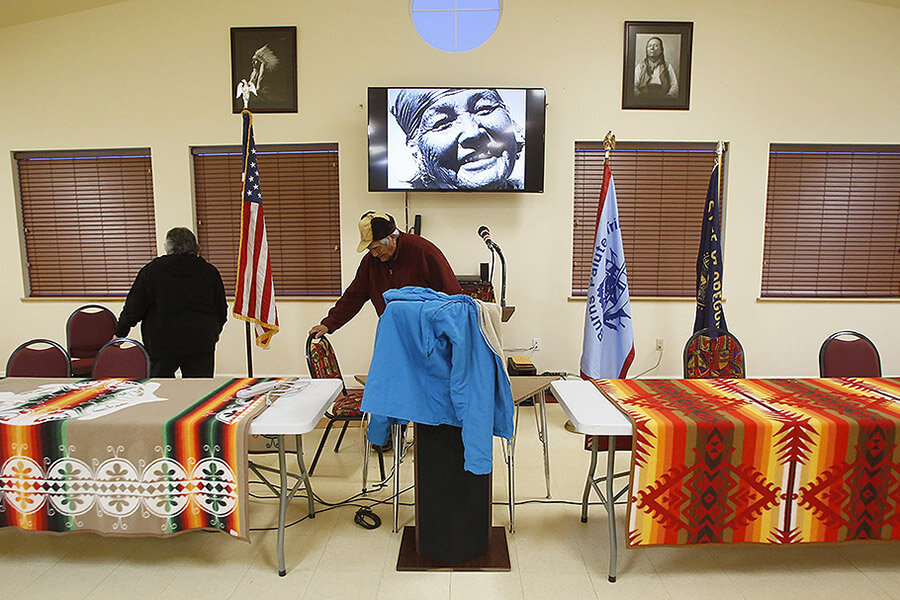Native Americans ask Oregon occupiers to remember the original 'owners'
Loading...
As the standoff between armed lands rights activists and federal officials near Burns, Oregon entered its fifth day Wednesday, the 20-some anti-government protesters occupying headquarters at the Malheur National Wildlife Refuge were still adamant that parkland be returned to the people.
"The idea is power: Land is power," protester and Montana Army veteran Ryan Payne told The New York Times on Tuesday. Mr. Payne and fellow occupiers argue that "the federal government unconstitutionally laid claim to land within the United States," and people who use and love the land – ranchers, miners, and loggers, among others – deserve to have it back.
That's a particularly familiar story for the nearly 3 million native Americans living in the US today, roughly one percent of the population.
And many tribes find it deeply ironic to see the country mesmerized by a 20-person standoff, watching occupiers call the American people the rightful owners of land that was taken from native communities under agreements that were frequently unequal, if not flat-out deceptive, or simply never honored.
"I don't give much credence to their cause," the Chairwoman of the Burns Paiute Tribe, Charlotte Rodrique, told Reuters on Wednesday.
Some Paiute are sympathetic to the protesters' general complaint that federal land management is overbearing. Tribal Council member Selena Sam, for instance, said that hunting and fishing restrictions from the government seem to be increasing.
But that doesn't mean she feels a sense of common cause with the protesters. "They’re like ‘Let’s grab some guns,' " she said of the Malheur protesters, roughly 35 miles away from the tribal reservation. "We have a different approach."
On Wednesday morning, Burns Paiute leaders held a press conference calling for the protesters, led by Ammon Bundy, the son of anti-federal activist Cliven Bundy, to pack their bags and leave the Paiute's former land. Reservation land established by the US government was cut down further as white settlers moved to the area, leading to armed conflict and the tribe's forced removal in 1878. Today, the tribe holds around 20 square miles.
"We've had a good working relationship with Malheur National Wildlife Refuge. We look at them as the protector of our cultural sites in that area," Ms. Rodrique told reporters. But she said that the occupation was "desecrating one of our sacred sites," and it was time for protesters to leave.
"We never gave up our aboriginal rights to the territory, so we as a tribe actually view this as our land, no matter who is living on it,” she said. "We were here first and just want to set the facts straight."
In 1908, then-President Theodore Roosevelt set aside 188,000 acres for the Malheur National Wildlife Refuge, intended "as a preserve and breeding ground for native birds."
"When the militia talks about giving [the land] back to original owners, they were not ranchers. They were tribes," Portland Audubon Society conservation Director Bob Sallinger told the Monitor on Tuesday. "If they are really interested in returning [the land] to the original owners, it would be the Paiute tribe."
For some, the wildlife occupation brings to mind the American Indian Movement's 1973 occupation of Wounded Knee, South Dakota. Wounded Knee was the site of an 1890 massacre, when troops responding to settlers' fears over a native religious movement killed 300 Sioux men, women, and children on the Pine Ridge Reservation – today, one of the poorest places in America.
Frustrated by a lack of progress pushing civil rights complaints against an allegedly corrupt tribal chairman, armed activists led a two-month standoff against government officials in 1973. Another demand was that the United States honor the terms of its 1868 treaty with the Sioux.
Two of the occupiers were killed, and many were charged in court.
Native advocates say there's no comparison, however, between the Wounded Knee grievances, which were the legacy of systemic violence and discrimination against Native Americans, and the Oregon occupiers' complaints.
In 2012, United Nations investigator James Anaya urged the US government to return some tribal lands to native communities to combat that legacy. The UN Declaration of the Rights of Indigenous Peoples, adopted in 2007 – but not by the United States – declares "Indigenous peoples have the right to the lands, territories, and resources which they have traditionally owned, occupied, or otherwise used or acquired."
Money settlements for land are "important steps," Mr. Anaya told the Guardian, "but there are these deeper issues that need to be addressed."
In 1980, the US Supreme Court awarded $570 million to the Sioux as compensation for the Black Hills, which the tribe considers sacred. After discovering gold there, the US government claimed them in the late 1800s, undoing an 1868 agreement to cede them to the Sioux. Today that money, now $1 billion, still sits untouched: The Sioux say they don't want it, despite dire poverty on the reservation. They're waiting for the land itself.
"How do you put a price tag on spirituality?" Chick Big Crow asked the Los Angeles Times in 2001.








